Full Body Workout vs. Split Routine
There are many different ways you can structure your workouts in the gym for successful results. The training design you ultimately decide upon is usually determined by a combination of your individual goals and the type of routine you enjoy doing.
Whether you’re working towards a weightlifting competition or exercising purely for athletic development, you may find yourself asking:
Which type of workout plan is best, one with full-body workouts or one using split routine sessions?
The short answer to this question is that both types of workout are equally effective at building muscle, so long as a regular routine and proper nutrition is followed.
Note:
Solid nutrition will help you maximize results quicker. It's been said that you can't out-exercise a poor diet.
That being said, full-body workouts are generally considered the best method for building the leanest, strong, and well-rounded body possible.
This guide will take a further in-depth look at the hotly-contested debate in the fitness industry, including some of the main pros and cons for each workout and the different types of athletes suited to the physical demands of the two popular exercise regimes.
With all this in mind, you should be in a much better place to make an informed decision about which type of exercise routine is best for your individual fitness needs.

Full Body vs. Split: What’s The Difference?
Just so we’re all on the same page, full-body workouts are a combination of exercises designed to stimulate several different muscle groups during the same workout. On the other hand, split routines divide your muscle groups and specific movement patterns on different days.
For example, suppose your exercise plan has you working out four days a week. In that case, you can complete shoulder and arm exercises on one day, legs on another, chest and back on the third, and then cardio and core on the final day.
Before taking a look at some of the pros and cons for full-body workouts and split routines, it’s essential to first recognize that the pros can vary from coach to coach. This is because each coach has their own area of expertise, and the structure of their program may be completely different from that of another coach.
Full Body Workout: Pros
- Firstly, one of the greatest things about a full-body workout is their time efficiency. Suppose you have a busy work schedule and have limited time in the gym. In that case, full-body workouts are the perfect way to maximize your time and work on multiple areas of the body.
- Full-body workouts allow you to build a well-balanced body by targeting several different muscle groups in the same workout. This point is reinforced by psychologists who believe that splitting up the body’s muscles for each workout doesn’t make functional sense.
- While this isn’t always guaranteed, the vast majority of the time, full-body workouts produce a more significant energy expenditure per session. This is because performing exercises across several muscle groups provides a higher caloric burn than split routines.
- In general, full-body workouts are more fun and challenging due to the variation of different exercises.
Full Body Workout: Cons
- With such a wide variety of exercises, hitting a specific muscle group can be challenging intensely. This is particularly apparent for legs with the intensity often too hard to handle, along with the lengthy post-workout recovery time.
- Full-body workouts can be slightly more challenging when managing fatigue, with over training a common problem. Workouts need to be appropriately structured because hitting several muscle groups too strongly at a time will likely result in an over training response.
Full Body Workout: Who Should Use It?
Suppose you’re an athlete that prefers cardio over lifting heavy. In that case, full-body workouts (ideally circuit training workouts) are a great way to keep your whole body fit and healthy.
Beginners and older adults should also stick to full-body workouts. This is because these workouts not only help to build an all-around healthy body, they’re also more fun and challenging.
Finally, athletes who enjoy metabolically intense workouts should use full-body sessions. Anyone who wants to burn more calories and reduce fat could also add HIIT workout sessions as well. For example, suppose you lift heavy weights and push yourself to the limit and maximize calorie burn every session. In that case, full-body workouts provide the ideal balance.
A quick note that these example workouts were made with free weights in mind. It’s not only possible to do full body or split workouts with body weight exercises but incorporating even basic exercises like pull-ups and chin-ups as well as bar or bench dips are excellent additions to any plan.
Example Full Body Workout
This work is a basic example of what type of routine you might follow on a full body workout day. A full boy will use fewer exercises that target multiple muscles.
| Exercise | Sets | Reps |
| Bench press | 3 | 10 |
| Lat pulldown | 3 | 10-15 |
| Squats | 3 | 10 |
| Leg curls | 3 | 15 |
| Should press | 3 | 10 |
| Incline curls | 3 | 12 |
| Triceps press down | 3 | 15 |
Full Body Workout Schedule
Schedules can be arranged on any day. Monday for example doesn’t have to be a workout day if your personal schedule doesn’t line up. Plan for your time and be consistent.
| Workout # | Day | Do This |
| 1 | Monday | Workout |
| 2 | Tuesday | Rest |
| 3 | Wednesday | Cardio (or missed day make-up) |
| 4 | Thursday | Workout |
| 5 | Friday | Rest |
| 6 | Saturday | Workout |
| 7 | Sunday | Rest |

Split Routine: Pros
- Perhaps the best thing about following a split routine workout is that you can focus on shaping individual muscles. Suppose you want to put all your energy into one or two different muscle groups per day. In that case, this can provide you with greater control over the targeted development of your physique.
- Split routines are also great for prioritizing maximal strength. Suppose certain muscle groups are only being trained once or twice a week. In that case, this allows you to exert more energy into pushing your strength limits each session. It’s unrealistic to push these limits without sufficient recovery levels, so splits are the perfect solution.
- Suppose you like to switch up your workout routine from time to time. In that case, this is incredibly easy with split routines, as the nature of the exercises allows you to target different muscle groups on other days.
Split Routine: Cons
- If you decide to skip a training session, this can be problematic if you’re following a split routine. For most muscle groups, you’ll be training them once a week, so if you miss a session, it could be as long as two weeks before you get a chance to target that same muscle group again.
- As mentioned earlier, split routines typically produce a lower caloric burn than full-body workouts. For example, a workout solely focused on arms is almost always burns considerably fewer calories and fat than workouts that target the whole body.
- Suppose your split workout routine isn’t structured correctly. In that case, you’ll likely over-develop certain areas of your body at the expense of others. This will lead to muscle and strength imbalances that are impractical and far from flattering on the eye (think massive arms and tiny legs).
Split Routine: Who Should Use It?
For fitness models and bodybuilders, split routines are designed perfectly to hit specific muscle groups, lift heavy weights, and have considerable control over shaping a physique.
Furthermore, advanced and experienced lifters that regularly attend the gym, or lift weights at home four to five times a week, should stick to split routine training.
So long as they’re also hitting their core and leg muscles on at least one of those days and have their nutrition under control, there’s no reason to change. Unless body fat levels are over 20% because of lower calorie burn.
Example Split Workout
Split workouts are going to cover fewer exercises than full body. This example gives you an idea of how a split workout would be structured.
| Exercise | Sets | Reps |
| Bench press | 3 | 10 |
| Squats | 3 | 10 |
| Rows | 3 | 10 |
Split Routine Workout Schedule
The same goes for split routing schedules regarding planning. Align the workout number with the days that work best for you. But keep to a schedule and stay consistent.
| Workout # | Day | Do This |
| 1 | Monday | Workout |
| 2 | Tuesday | Rest |
| 3 | Wednesday | Workout |
| 4 | Thursday | Rest |
| 5 | Friday | Workout |
| 6 | Saturday | Cardio |
| 7 | Sunday | Rest |
Making The Decision…
Suppose you’re still struggling in terms of deciding which training style is best to employ in your next training program. In that case, it may be worth giving a little extra thought to the following two areas.
Current Goals
This is the most crucial consideration when choosing a training design. The more specific your goals are, the more specific your training program will need to be.
If your primary goal over eight weeks is to focus on a couple of body lifts and improve their strength, using a split routine is the easiest way to increase the volume in goal-oriented areas.
However, if your time in the gym is limited and you’re trying to maximize results, then full-body workouts are the best option. Because they hit multiple muscle groups simultaneously.
Sport-Specific Training
Relating your training program to the sport you’re involved in is another important consideration you shouldn’t overlook. You’ll need to take into account how specific your gym sessions need to be for your sport, as well as how often you’re practicing and whether your workouts will interfere.
Other focus points should be managing fatigue between workouts to providing an effective runway for future mesocycles, and perhaps more important than anything else, improving sports performance.
The Bottom Line: Which Is Better?
All things considered, the debate between full-body workouts and split routine sessions do not have a conclusive winner. However, both program styles provide numerous benefits that can help you achieve the vast majority of your training goals.
Just be sure to consider how each will fit into your lifestyle and goals because everyone is different.
Generally speaking, if you want to develop a well-balanced, functionally fit body. Full-body workouts are the way forward, whereas split routine training is a perfect choice if you’re looking to prioritize maximal strength and build specific muscle groups.
- 5 Best Power Towers For Your Home Gym - July 19, 2023
- What Does Natty Mean in Body Building? Is It Good or Bad? - June 26, 2023
- How Much Creatine Is In Bang? The Amount Might Surprise You - June 25, 2023

